Snapshots of family relationships
Snapshots of family relationships
You are in an archived section of the AIFS website
Download Research snapshot
Overview
The analysis outlined in this snapshot of family relationships suggests the following five key trends:
- First, dramatic changes have occurred in patterns of couple formation and dissolution, family size and the incidence of ex-nuptial births. Marriage rates have declined and, although cohabitation rates have increased, overall partnership rates have declined. The total fertility rate has fallen overall, while there has been an increase in the proportion of babies born outside marriage. The proportion of women who have three or more children has fallen, while there have been increases in the proportions who remain childless or end up having only one or two children, with two children being the most common outcome.
- Second, consistent with the trends on partnership dissolution, nearly half the parents with a child under 18 years acknowledge that it is not easy to maintain good relationships nowadays. In addition, more than half reject the view that relationship or parenting skills come naturally to most people.
- Third, in the context of high separation and divorce rates, most family relationships tend to be evaluated positively by family members. Nevertheless, a substantial minority of partnered parents with a child under 18 years report that they have experienced difficulties in their relationship with their partner, with most believing that these difficulties had been resolved.
- Fourth, distant or negative relationships are relatively common between separated parents, and between step-parents and step-children (especially for young step-mothers and teenage girls), while distant relationships seem also to be common between children and their grandparents on their non-resident fathers' side.1
- Finally, although most parents acknowledge that, after parental separation, children are usually better off if both parents remain involved in their lives, a substantial proportion of children rarely/never see or stay overnight with their non-resident parent.
These results provide a positive picture of family relationships in general, while also highlighting some areas of concern. Regarding the latter, the negative repercussions of the breakdown in the relationship between parents can be long-lasting, increasing the risks that children will have little if any contact with their non-resident father and will experience a more distant relationship with their paternal grandparents. Should re-partnering occur, then relationships between step-parents and step-children can be problematic. on the other hand, the vast majority of partners and of parents and children describe their relationships with each other in a favourable light, and even though relationships between partners are not always rosy, their problems can often be overcome. Such findings suggest a great deal of resilience in families.
1. Relationships between grandchildren and grandparents on the non-resident mothers’ side could not be ascertained.
Our sense of wellbeing is closely linked with how happy we are with our relationships with other people, especially those that are most important to us. Of these, relationships within families loom large, affecting all members, the family as a whole, and the community. If relationships in the family are supportive and enjoyable, then the challenges we face both within and outside the family can seem less daunting than otherwise. The souring of family relationships, on the other hand, can be a devastating experience in which our "refuge" can become a "minefield".
Clearly, it is in the community's interests that we continue to monitor family relationships, and keep a close watch on the broad range of factors that may enhance or threaten the wellbeing of Australia's most precious resource - its families.
To celebrate National Families Week in 2008, the Australian Institute of Family Studies prepared this Snapshot of Family Relationships. This report, which was commissioned by the Australian Government Department of Families, Housing, Community Services and Indigenous Affairs (FaHCSIA), provides a brief outline of the following issues:
- trends in couple formation, dissolution and family size;
- the personal satisfaction teenagers and adults derive from their family relationships (including step-relationships) and parents' views about the closeness of relationships between their own parents and children;
- parents' opinions about various issues, such as the ease or difficulty most parents have in raising children;
- the sources of professional support that parents expect they would use if they were separating from their partner or had difficulties in handling their children's behaviour, and any professional support that they have used; and
- post-separation patterns of parenting.
I would like to thank FaHCSIA not only for commissioning this report, but also for providing a great deal of encouragement from its inception to finalisation. This has indeed been an excellent relationship! Lixia Qu and Ruth Weston are to be congratulated on this excellent piece of work that provides a valuable and accessible picture of Australian family relationships.
Professor Alan Hayes
Director
Australian Institute of Family Studies
Trends in couple partnering and childbearing
- Marriage rates have fallen in recent decades, while cohabitation rates have increased.
- The crude divorce rate has remained at a high plateau over the past decade, while the proportion of cohabiting couples who separate has increased progressively.
- These trends have contributed to the decline in the proportion of Australian adults of all ages who are living with a partner.
- The total fertility rate fell almost continuously between 1961 and 2001 and has since increased slightly.
- The overall decline in the total fertility rate has resulted from an increase in the proportion of women who remain childless or who end up having only one or two children, and a decrease in the proportions who have had three or more children (especially four or more children).
- The proportion of children born outside marriage has increased dramatically since the 1960s.
Relationships between partners
- Most partnered men and women reported high satisfaction with their relationship with their partner, with those aged 65 years and over being the most likely to indicate this, and all those aged 35-44 and women aged 45-54 being the least likely to do so.
- Around one-third of mothers and fathers (with a child under 18 years) indicated that they had experienced difficulties with their current relationship. Of these, close to 20% indicated that they had separated for a time, and most indicated that they were "over" these difficulties.
Opinions about developing and maintaining good relationships with a partner
- Nearly half the parents with a child under 18 believed that it "it's hard for couples to maintain a good relationship in today's society".
- Just over half rejected the notion that "the skills needed to maintain a good relationship with their partner come naturally to most people".
- A cautious outlook (that it is difficult to maintain good relationships and that good relationship skills do not come naturally to most people) was more apparent among mothers than fathers and among older than younger age groups.
Help-seeking if separating from a partner
- Before prompting, parents most commonly indicated that they would consult lawyers/legal services and counsellors or similar professionals if they and their partner were separating, with a substantial minority indicating that they did not know where they would go for such advice or information.
- Those who had not already mentioned certain services were asked whether they would use them. When pre- and post-prompted answers were combined, counsellors or similar professionals represented the most "popular" source, followed by lawyers/legal services, then general health professionals.
- Mothers were more inclined than fathers to expect that they would use the above-mentioned sources.
- Just under half the fathers and mothers who had experienced separation indicated that they had sought professional help at the time of their separation or divorce. Counsellors or similar professionals were most commonly mentioned for advice or information, followed by a lawyer or legal service.
Relationships between parents and children
- Most parents reported high satisfaction with their relationships with their biological children, and only around one in ten indicated low satisfaction.
- Although just under half the male and female respondents (aged 15 years and over) with a living parent expressed high satisfaction with their relationship with their biological parents, such positive appraisals represented the most common view.
- Relationships between step-parents and step-children tended to be viewed less favourably than those between parents and their biological children.
- The oldest groups in each generation (biological parents. biological children, step-parents, and step-children) were the most likely to report high satisfaction.
- Of all the age groups of parents and children (biological and step), there were only two in which the majority expressed low satisfaction: step-mothers in the youngest group represented (aged 25-34 years) and teenage step-daughters.
Opinions about the ease or difficulty of attaining parenting skills
- Parents (with a child under 18 years old) were more likely to reject than accept the statement that the skills required to be a good parent come naturally to most people, especially mothers and older respondents.
- Mothers under 25 years old represented the only group in which the majority believed that good parenting skills come naturally to most people.2
Help-seeking for handling children's behavioural problems
- Most parents indicated that they would seek professional help should they experience difficulties in handling their children's behaviour, with counsellors or similar professionals being the most commonly nominated resources.
- However, one in three fathers and one in six mothers indicated that they did not know where they would go for help.
- A substantial minority of parents indicated that they had sought professional help, with a higher proportion of mothers than fathers stating this.
- Parents who had sought help were most likely to indicate that they had consulted counsellors or similar professionals, followed by general health professionals.
Post-separation parenting
- While a great deal of evidence suggests that amicable relationships between separated parents are beneficial for their children, only around half the separated mothers and fathers indicated that their relationship with the child's other parent was "friendly" or "cooperative".
- Around one-quarter said that they did not talk to their former partner at all about the children.
- Most mothers and fathers (living together or apart) agreed that "children generally do best after separation when both parents remain involved in their lives". However, this general viewpoint is not consistent with the overall patterns of contact between children and non-resident parents.
- Reports of resident parents suggest that, among children aged under 18 years who had a natural parent living elsewhere, about one in four rarely or never saw their non-resident parent.
- According to resident parents, around half the children never (or no longer) stayed overnight with their non-resident parent.
- Only 6% of the children spent at least 110 nights with their non-resident parent (i.e., at least 30% of nights per year).
- Of three groups (resident mothers and fathers, and non-resident fathers), non-resident fathers were the most likely to report paying child support (applying to the majority), while resident fathers were the least likely to do so (applying to a minority).3
Relationships between grandparents and grandchildren
- Most mothers and fathers described the relationship between their children and their maternal and paternal grandparents (particularly the former) as "close" or "very close", with relationships with maternal grandparents being more likely than those with paternal grandparents to be portrayed as "very close".
- Respondents' perceived relationships between their own parents and children differed according to whether: (a) they had separated from their children's other parent, and (b) they were living with the children:
- "Very close" relationships between the respondents' own parents and their children were most likely to be described by mothers who were not separated, followed by separated resident fathers, and separated resident mothers.
- On the other hand, "very close" relationships were least likely to be reported by non-resident fathers (only one in five).4
- At least half the separated fathers and mothers maintained that the relationship between their own parents and the children had not changed since they and their partner had separated.
- However, non-resident fathers were more likely to suggest that relationships between their own parents and children had become more distant than closer, while the reverse applied to resident fathers and resident mothers.
2. The views of fathers of this age were not assessed owing to the small number of respondents in this group.
3. Reports of non-resident mothers were not assessed owing to the small number of respondents in this group.
4. Results for non-resident mothers were not assessed owing to the small number of respondents in this group.
In Australia, as elsewhere, family structures, relationships, and lifestyles have changed profoundly over the last few decades - changes that reflect the way we respond to economic and social pressures and opportunities that arise within and beyond our families. In turn, family transitions themselves represent societal trends that affect economic and social pressures and opportunities, including those linked with changing social values.5 This chapter describes some key trends in couple formation and dissolution as well as childbearing.
Forming partnerships
Figure 1.1 depicts the crude marriage rates that were apparent between 1901 and 2006.6
Over the last 100 years or so, the crude marriage rate has fluctuated considerably:
- The rate declined in the 1920s (reaching a trough in 1931), then increased in the 1930s, and has mostly fallen since the 1970s. In recent years, the rate appears to have levelled out at around 5.4.
- The highest crude marriage rate was 12.0 (in 1942) and the lowest was 5.3 (in 2001).
While the crude marriage rate has declined in the last few decades, cohabitation has become more prevalent. The proportion of couples who cohabit rather than marry has increased progressively in the last two decades, from 6% in 1986 to 15% in 2006. Nevertheless, most couples who are living together are married to each other.
Figure 1.2 shows that cohabitation is more common among younger than older people.
- Although most men and women under 25 years old are neither married nor cohabiting, those of this age who were living with a partner were far more likely to be cohabiting than married.
- Marriage is more common than cohabitation for older age groups, with the dominance of marriage increasing with advancing age.
It is also worth noting that cohabitation has become the common pathway to marriage. The proportion of marriages taking place that were preceded by cohabitation was 16% in 1975, 45% in 1990, and 76% in 2006.
Figure 1.1 Crude marriage rate, 1901-2006

Sources: Australian Bureau of Statistics (ABS) (1996, 2002a, 2007a)
Figure 1.2 Men and women living with a partner, 2006, by partnership status and age

Source: ABS (2007b)
Dissolving partnerships
The increase in the divorce rate represents one of the most spectacular family-related trends of the 20th century. Figure 1.3 depicts the crude divorce rates7 between 1901 and 2006 and the number of children aged under 18 whose parents divorced between 1996 and 2006.
- Divorce was rare prior to the Second World War. The crude divorce rate rose slightly from the 1920s to the mid-1940s and peaked at 1.1 in 1947. The rate then declined slightly until the 1960s, when it began to rise substantially.
- The rate soared to a peak of 4.6 divorces when the Family Law Act 1975 came into operation in 1976.8
- Since the early 1980s, the crude divorce rate has fluctuated between 2.5 and 3.0, with a trough occurring in the mid-1980s. In recent years, the divorce rate has declined slightly (from 2.9 to 2.5 between 1996 and 2006).
- From 1966 to 2006 the number of children under 18 years whose parents divorced increased from 12,950 to 48,396, although it is important to note that the proportion of all divorces involving parents of children of this age fell from 65% to 50%.
Given that some people cohabit, trends in divorce do not provide an accurate picture regarding the incidence of relationship separation, especially among younger couples. Table 1.1 shows that cohabiting relationships are far more likely to dissolve than marriages.
- Regardless of the period in which cohabitation or marriage began, the likelihood of a cohabiting relationship ending in separation within five years was at least three times the likelihood of a marriage ending in divorce within five years (25-38% vs 7-9%).
- The proportion of marriages that ended in divorce within five years increased slightly over the period shown (from 7% of marriages starting in 1975-76 to 9% of marriages starting in 1994-95). Similarly, the proportion of cohabiting relationships that ended in separation increased over the period shown (from 25% of cohabitating unions that began in 1970-74 to 38% that began in 1990-94).
- However, for the entire period covered in Table 1.1 (approximately 20 years), the rate of separation among cohabiting couples increased to a greater extent than the rate of divorce among married couples. Of course, some couples would have separated but not divorced during this period.
Figure 1.3 Crude divorce rate, 1901-2006, and number of children (under 18 years old) whose parents divorced, 1996-2006
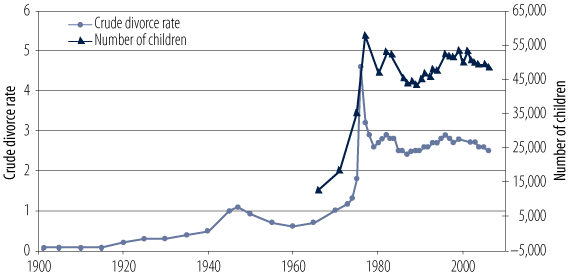
Sources: ABS (various years) Marriages and Divorces Australia; ABS (various years) Divorces Australia
Table 1.1 Cohabitation separations and divorces, by period in which cohabitation or marriage began
| Cohabitation(a) | Marriage | ||
| Year began living together | Separations within five years (%) | Year of marriage | Divorces within five years (%) |
| 1970-74 | 24.9 | 1975-76 | 6.9 |
| 1975-79 | 30.9 | 1985-86 | 7.5 |
| 1980-84 | 33.4 | 1987-88 | 7.9 |
| 1985-89 | 33.3 | 1989-90 | 8.6 |
| 1990-94 | 38.2 | 1994-95 | 8.8 |
Note: (a) Cohabiting relationships refer to first unions for one or both partners (based on the Household, Income and Labour Dynamics in Australia (HILDA) survey Wave 1 data); the separation rate does not take into account couples who went on to marry and then divorced subsequently.
Sources: ABS (2000); Australian Institute of Family Studies (AIFS) (2004)
Partnered individuals
The above trends indicate that marriage rates have fallen while divorce rates have remained at a high plateau in recent years. On the other hand, cohabitation rates have increased while the chance of cohabitation ending in separation has also increased. Together, these trends affect the overall proportions of adults who are partnered or unpartnered.
Figures 1.4 and 1.5 show the proportions of men and women of different ages who were living with a partner in 1996 and 2006, and the proportions who were married in 1976. Given that very few couples cohabited in 1976, these percentages are a reasonable (slightly conservative) indicator of partnership rates in this period.
- From 1976 to 1996, the partnership rate fell dramatically for all age groups of men and women, especially for the two age groups under 30 years:
- For men, the partnership rate declined from 32% to 15% for those aged 20-24 and from 72% to 42% for those aged 25-29 years during the two decades.
- Likewise, the partnership rate for women in these two age groups fell considerably (20-24 years: 59% to 27%; 25-29 years: 84% to 57%).
- In the most recent decade (from 1996 to 2006), the partnership rate continued to fall for most age groups.
Figure 1.4 Men married in 1976 and living with a partner in 1996 and 2006, by age

Note: Based on place of usual residence for 1996 and 2006. Almost all couples were married in 1976.
Source: ABS (2000, 2007b)
Figure 1.5 Women married in 1976 and living with a partner in 1996 and 2006, by age

Note: Based on place of usual residence for 1996 and 2006. Almost all couples were married in 1976.
Source: ABS (2000, 2007b)
Childbearing
The decrease in partnership rates and increase in the fragility of relationships have combined with a range of other factors, such as an increasing age at marriage, to influence the number of children women have (see McDonald, 2006; Weston, 2004). In addition, the increase in cohabitation rates and shifting attitudes about family formation, have affected the proportion of all children who are born outside marriage.
Total fertility rate
The total fertility rate9 has declined markedly since the 1960s. It peaked in 1961 (3.55) and fell almost continuously through the next few decades. It reached its lowest level in 2001 (1.73). In 2006 the rate was 1.81.
Number of children
The total fertility rate provides an average estimate of the number of children a woman is likely to bear, but offers little information about how family size has changed. Figure 1.6 shows the number of children that women aged 40-44 years have ever had, across different Census periods.
- From 1981 to 2006, the proportion of women who had two children increased substantially (from 29% to 38%), while the proportion of women who had three or more children fell (from 55% to 33%), with the greatest fall occurring for those who had four or more children (from 28% to 11%).
- The proportion of women who had one child and who had no children also increased during the two decades (from 8% to 13% and 9% to 16% respectively).
Figure 1.6 Number of children ever born to women aged 40-44, 1981-2006
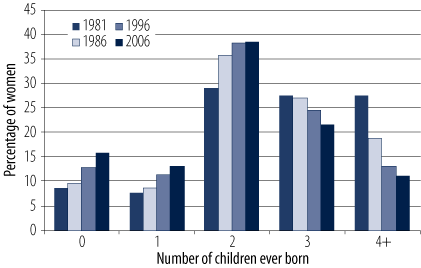
Sources: ABS (2002a, 2006)
Ex-nuptial births
While the total fertility rates over the last decade have been the lowest on record, the proportion of children born outside of marriage has increased progressively, from around 4-6% in the early 1960s to 33% in 2006.
Although it is not clear how many of these children were born to cohabiting couples, the increase in the ex-nuptial birth rate corresponds with the increasing number of cohabiting couples and with the increasing proportion of babies whose birth certificates contain the father's name. The proportion of birth certificates containing the father's name increased from 58% in 1980 to 90% in 2006 (ABS, 2001, 2007c).
5. As de Vaus (1997) noted, changes in family patterns have challenged and often led to greater tolerance of new ways of living and represent societal trends that affect the size and age structure of the population, the environment, the economy and legislation.
6. The crude marriage rate refers to the annual number of registered marriages per 1,000 members of the resident population.
7. The crude divorce rate refers to the annual number of divorces per 1,000 members of the resident population.
8. The Act allowed divorce on only one ground - "irretrievable breakdown" - as measured by at least 12 months of separation. It led to the formalisation of some long-term separations and the bringing forward of some divorces that had been filed in the previous years but had not been finalised.
9. The total fertility rate is a synthetic measure that refers to the number of babies a woman can expect to have in her lifetime, given the age-specific birth rates prevailing at the time. It is affected by trends in accuracy of birth registration data, including the tendency to register a birth and the timing of registration. According to Hugo (2007), delays in birth registrations contributed to the apparent decline in the fertility rate after 1992, while improvements in the accuracy of birth registration data have contributed to the apparent increase after 2001.
The quality of intimate relationships is a pivotal factor affecting personal wellbeing (see, for instance, Brown, 2000; Dolan, Peasgood, & White, 2006; Haller & Hadler, 2006; McCabe, Cummins, & Romeo, 1996; Tweng & King, 2005). These relationships include those between partners and between children and their parents, especially before the children reach maturity. Relationships between other people whom we love can also affect our personal wellbeing. This particularly applies to children, where the quality and stability of the relationship between their parents is of critical importance to their wellbeing (Amato & Booth, 2000; Pryor & Rodgers, 2001; Smyth & Wolcott, 2004).
This chapter focuses on: (a) men's and women's satisfaction with their relationship with their partner, (b) parents' previous experience of relationship difficulties with their current partner, (c) opinions of parents about the ease or difficulty with which couples maintain a good relationship, and (d) parents' expectations about where they would go to obtain advice or information if they were separating from their partner, along with actual use of professional help by those who have experienced separation or divorce.
Satisfaction with relationship with partner
In each wave of the Household, Income and Labour Dynamics in Australia (HILDA) survey,10 respondents (all of whom are aged 15 years and over) are asked to rate their satisfaction with their relationship with various people, including their current partner (where relevant). Ratings range from 0, "completely dissatisfied", to 10, "completely satisfied". The following analysis concerning relationship satisfaction is based on data from Wave 4 of the survey, conducted in 2004.
A favourable picture of relationships was revealed:
- More than half the men and women (56-61%) indicated high satisfaction (ratings of 9 or 10) with their relationship with their partner.
- Only 10-15% reported low satisfaction (ratings 0 to 6). Moderate satisfaction (ratings 7 or 8) was reported by 29% of men and women separately.
- Men were slightly more likely than women to express high satisfaction with their relationship (61% vs 56%).
Figure 2.1 shows the proportion of men and women in different age groups who were highly satisfied (ratings of 9 or 10) with their relationship with their current partner.11
- Those least likely to report high satisfaction were men and women aged 35-44 years (53% of men; 47% of women) and women aged 45-54 years (49%).
- For older age groups, the proportions expressing high relationship satisfaction increased progressively with age:
- Men aged 65 years and older were the most likely of all male groups to indicate high satisfaction (75%), followed by men aged 55-64 years (70%).
- Women aged 65 years and older were marginally more likely than those under 25 years old to express high satisfaction (71% and 67% respectively).
- Among those under 25 years old, a higher proportion of women than men indicated high satisfaction (67% vs 59%), while for other age groups, the proportion of men expressing high relationship satisfaction was at least marginally greater than that of women.
Figure 2.1 Reports of high satisfaction with relationship with current partner, by age and gender
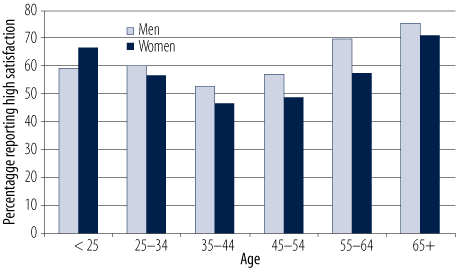
Note: High satisfaction refers to ratings of 9 or 10 on a scale ranging from 0, "completely satisfied" to 10, "completely satisfied".
Source: HILDA 2004
Previous experience of relationship difficulties among parents
In the General Population of Parents Survey (GPPS) conducted in 2006,12 parents who were living with a partner were asked: "At any stage, have you thought your relationship might be in real trouble?" Those who answered in the affirmative were then asked whether they were "over these problems now", whether they had ever separated from their partner and if they had, for how long they had separated.
- Around one-third (32-33%) of mothers and fathers indicated that they had experienced difficulties in their current relationship.
- Among parents who indicated that they had experienced difficulties in their current relationship:
- most of the fathers and mothers (87% and 83% respectively) reported that they were "over" these difficulties at the time of the survey;13
- only 18% of fathers and 20% of mothers indicated that they and their partner had resorted to a period of separation; and
- of those who experienced separation from their current partner, about half (58% of fathers; 45% of mothers) reported that the separation lasted three months or less, while 15% of fathers and 25% of mothers reported that the separation lasted for more than 12 months.
Selected opinions about couple relationships
In the GPPS 2006, parents were asked to indicate their level of agreement or disagreement with the statements: "The skills needed to maintain a good relationship with their partner come naturally to most people", and "It's hard for couples to maintain a good relationship in today's society".14
- Most parents had an opinion on the two issues. The statements (taken separately) generated mixed feelings or uncertainty in only 9-10% of fathers and 10-13% of mothers.
- Parents were more likely to disagree than agree with the statement that "the skills needed to maintain a good relationship with their partner come naturally to most people" (fathers: 51% disagreed and 38% agreed; mothers: 55% and 32%).
- Parents seemed to be more evenly divided regarding the notion that "it's hard for couples to maintain a good relationship in today's society" (fathers: 45% agreed and 45% disagreed; mothers: 50% and 40%).
In general, then, both fathers and mothers (but especially mothers) were more inclined to indicate a cautious rather than confident outlook.15
Figures 2.2 and 2.3 show the proportions of mothers and fathers in different age groups who agreed (either strongly or moderately) with these two statements.
- Regarding the statement that "the skills needed to maintain a good relationship with their partner come naturally to most people", fathers' and mothers' tendency to endorse the statement declined with age, suggesting a more cautious outlook among older than younger groups. For example, 53% of mothers aged under 25 years agreed with the statement, compared with 39% of mothers aged 25-34 years and 27% of mothers aged 45-54 years.
- Concerning the statement that "it's hard for couples to maintain a good relationship in today's society", fathers' tendency to endorse the statement increased with age, suggesting a greater caution among older than younger fathers. However, mother's opinions varied only slightly with age.
Figure 2.2 Strong agreement/agreement with the statement "The skills needed to maintain a good relationship with their partner come naturally to most people", by age and gender
[[{"fid":"3431","view_mode":"full","fields":{"format":"full","field_file_image_alt_text[und][0][value]":"Figure 2.2 Strong agreement/agreement with the statement "The skills needed to maintain a good relationship with their partner come naturally to most people", by age and gender","field_file_image_title_text[und][0][value]":""},"type":"media","attributes":{"alt":"Figure 2.2 Strong agreement/agreement with the statement "The skills needed to maintain a good relationship with their partner come naturally to most people", by age and gender","class":"media-element file-full"}}]]
Note: Results for fathers who were under 25 years old and for mothers aged 55 years or over are not provided owing to the small number of respondents in these groups.
Source: GPPS 2006
Figure 2.3 Strong agreement/agreement with the statement "It's hard for couples to maintain a good relationship in today's society", by age and gender
[[{"fid":"3432","view_mode":"full","fields":{"format":"full","field_file_image_alt_text[und][0][value]":"Figure 2.3 Strong agreement/agreement with the statement "It's hard for couples to maintain a good relationship in today's society", by age and gender","field_file_image_title_text[und][0][value]":""},"type":"media","attributes":{"alt":"Figure 2.3 Strong agreement/agreement with the statement "It's hard for couples to maintain a good relationship in today's society", by age and gender","class":"media-element file-full"}}]]
Note: Results for fathers who were under 25 years old and for mothers aged 55 years or over are not provided owing to the small number of respondents in this group.
Source: GPPS 2006
Sources of advice or information regarding separation
Where do people expect they would go for advice or information (other than family or friends) if they were separating from their partner? This question was asked of respondents (all of whom were parents of at least one child under 18 years) in the GPPS 2006, regardless of whether they were single or living with a partner. In addition, parents were specifically asked whether they would seek advice or information from the following sources if they had not already nominated these sources: counsellors or similar professionals; doctors/general practitioners; community health centres; lawyers or legal services; and priests, religious leaders or elders. Those who had divorced or who had separated from a partner with whom they had lived for at least three months were also asked whether they had sought professional help at the time of separation or divorce.
Table 2.1 shows the most common responses provided by the parents regarding the sources of help they would use if they were separating from a partner. The results in the columns entitled "Before prompting" refer to the percentages of respondents who volunteered that they would use the different sources of help listed before any source was suggested to them, while the results in the columns entitled "After prompting" refer to the total proportion of respondents who either indicated that they would use the services at the outset (i.e., before prompting) or after each type of service had been suggested to them.
Table 2.1 Expected sources of help that would be used by parents if separating from their partner, by gender
| Before prompting | After prompting | |||
| Fathers (%) | Mothers (%) | Fathers (%) | Mothers (%) | |
| Counsellors or similar professionals (e.g., psychologist, psychiatrist, social worker, or teachers) | 29.9 | 30.4 | 57.5 | 64.5 |
| Lawyer/legal services | 28.6 | 32.9 | 40.8 | 51.0 |
| General health professionals | 8.5 | 13.8 | 34.3 | 44.9 |
| Priests, religious leaders/elders | 5.4 | 4.1 | 22.4 | 18.6 |
| Don't know | 23.7 | 19.5 | - | - |
| Would not use any service | 7.7 | 5.5 | - | - |
| Number of observations | 2,237 | 2,744 | 2,237 | 2,744 |
Source: GPPS 2006
Pattern of results before prompting
- Before prompting, the most commonly mentioned sources for advice or information were lawyers/legal services (29-33%), and counsellors or similar professionals (30%), followed by general health professionals (9-14%).
- Each of the other sources was mentioned by less than 7% of fathers or mothers (the range of sources is not shown in Table 2.1).
- Around 20-24% of mothers and fathers reported that they did not know where they would go for advice or information if they and their partner were separating.
Pattern of results after prompting
- Not surprisingly, when asked whether they would use specific services, some parents responded in the affirmative, leading to an overall increase in the proportions of parents who indicated that they would use these services (either before or after prompting).
- The most "popular" sources for advice or information were counsellors or similar professionals (58-65%), followed by lawyers/legal services (41-51%), then general health professionals (34-45%).
- The proportions of parents who indicated that they would go to a priest, religious leader or elder increased from 4-5% before prompting to 19-22% after prompting.
- Except for the consultations with a priest, religious leader or elder, mothers were more inclined than fathers to indicate after being prompted that they would use the services.
Use of professional help at the time of separation or divorce
- Just under half the fathers and mothers indicated that they had sought professional help at the time of their separation or divorce.
- Mothers and fathers who said that they had sought help at the time of separation or divorce were most likely to indicate that they had turned to a counsellor or similar professional (69%), followed by a lawyer or legal service (mothers: 40%; fathers 33%). General health professionals represented the third most commonly reported service used (mentioned by 15-19%).
10. See the appendix for information about this survey.
11. It is interesting to note that similar patterns have been observed for subjective wellbeing (see Dolan et al., 2006).
12. See the appendix for information about this survey.
13. This is not surprising given that questions only focused on those who were currently living with a partner, not those who were currently separated or divorced.
14. Through probing, parents indicated whether they "strongly agreed", "agreed", held "mixed feelings", "disagreed" or "strongly disagreed" with each statement. Some parents volunteered that they were uncertain about the matter.
15. Here, a cautious outlook is suggested by the opinions that skills do not come naturally to most people and that it is difficult to maintain good relationships, while a confident outlook is suggested by the opinions that skills come naturally and that it is not difficult to maintain good relationships.
The previous chapter focused on relationships between parents or between partners in general. While research suggests that such relationships are critical to the wellbeing of the partners themselves, there is also evidence supporting the common-sense notion that children are particularly likely to thrive if they live with both biological parents who care deeply for them as well as for each other (see Amato, 2005; Ambert, 1997). Furthermore, it appears that the quality of parent-child relationships can have a profound impact on other relationships within the family, including those between the parents (Sanders, Nicholson, & Floyd, 1997). Less is known about the quality of relationships between adults and their parents or step-parents.
This chapter focuses on three issues: (a) the quality of relationships between parents and children (whatever their age) - both biological and step (as measured by ratings of satisfaction), (b) parents' opinions about whether parenting skills come naturally to most people, and (c) parents' expectations about the sources of help they would use if they experienced parenting difficulties, and any they had used.
Satisfaction with relationships between parents and biological children
Figure 3.1 shows the levels of satisfaction with relationships between parents and biological children reported by all parents (including those with adult offspring) and all children aged 15 years and older (including adults) who participated in Wave 4 of the HILDA survey (conducted in 2004).
- Most parents (58-61%) indicated high satisfaction (ratings of 9 or 10) with their relationship with their children and few (10-13%) reported low satisfaction (ratings of 0-6). About 29% of both fathers and mothers expressed moderate satisfaction (ratings of 7 or 8).
- Likewise, sons and daughters most commonly expressed high satisfaction, followed by moderate satisfaction. However:
- a lower proportion of children than parents expressed high satisfaction (just under half the children, compared with around 60% of parents); and
- a higher proportion of children than parents expressed low satisfaction (20-22% vs 10-13%).
Figure 3.1 Ratings of satisfaction with relationship with biological children (reported by parents) and with biological parents (reported by children aged 15 or more years)
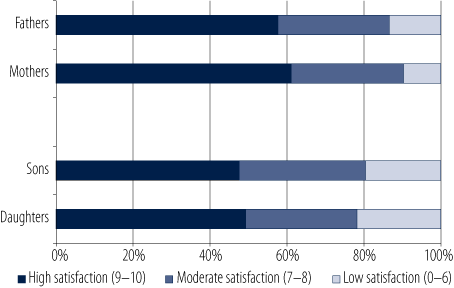
Note: High satisfaction refers to ratings of 9 or 10 on a scale ranging from 0, "completely satisfied" to 10, "completely satisfied".
Source: HILDA 2004
Figures 3.2 and 3.3 present the proportion of parents in different age groups who reported high satisfaction (ratings of 9 or 10) with their relationship with their biological children and the proportion of children in different age groups who indicated high satisfaction with their relationship with their biological parents.
Figure 3.2 Parents who reported high satisfaction with their relationship with their biological children, by parents' age

Note: High satisfaction refers to ratings of 9 or 10 on a scale ranging from 0, "completely satisfied" to 10, "completely satisfied". Results for fathers under 25 years old are not presented owing to the small number of respondents in this group.
Source: HILDA 2004
Figure 3.3 Children who reported high satisfaction with their relationship with their biological parents, by children's age
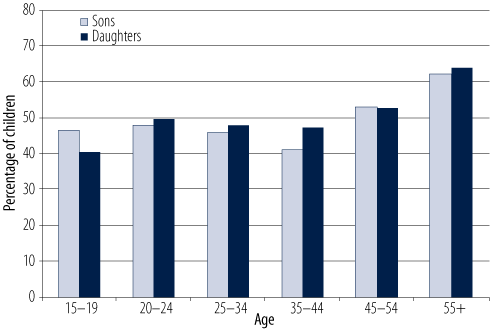
Note: High satisfaction refers to ratings of 9 or 10 on a scale ranging from 0, "completely satisfied" to 10, "completely satisfied".
Source: HILDA 2004
Parents
For both fathers and mothers, the proportion reporting high satisfaction first declined with age, then increased, reflecting a "U-shaped" relationship between high satisfaction and age.
- The oldest fathers and mothers (65 years or more) were the most likely to report high satisfaction (fathers: 69%; mothers: 73%), followed by the youngest groups (fathers aged 25-34 years: 64%; mothers aged less than 25 years: 67%).
- Those who were least likely to report high satisfaction were fathers aged 35-44 years and 45-54 years (49-51%) and mothers aged 45-54 years (53%).
Children aged 15 years and older
- The oldest sons and daughters (aged 55 or more years) were the most likely to express high satisfaction (62% and 64% respectively), followed by the second oldest sons and daughters (aged 45-54 years) (53% each).
- Sons aged 35-44 years were the least likely of all sons to express high satisfaction (41% vs 46-62%), while teenage girls were least likely of all daughters to report high satisfaction (40% vs 48-64%).
Satisfaction with relationships between step-parents and step-children
Figure 3.4 shows the patterns of satisfaction ratings provided by relevant respondents aged 15 years and older regarding their relationship with their step-parents and/or step-children.
- Each of the three levels of satisfaction (high, moderate or low) was indicated by no more than two-fifths of the step-parents.
- Parents' satisfaction with their relationships with their step-children was considerably lower than that reported for relationships with biological children. Whereas around 60% of parents indicated high satisfaction with their relationship with their biological children, high satisfaction with relationships with step-children was expressed by only 31-39% of step-parents.
Figure 3.4 Ratings of satisfaction with relationships with step-children (reported by step-parents) and with step-parents (reported by step-children aged 15 or more years)

Note: High satisfaction refers to ratings of 9 or 10 on a scale ranging from 0, "completely satisfied" to 10, "completely satisfied".
Source: HILDA 2004
- Likewise, children's satisfaction with their relationship with their step-parents was lower than that reported for relationships with biological parents. Whereas nearly half the sons and daughters expressed high satisfaction with their relationships with their biological parents, only 30-34% of step-sons and step-daughters provided such favourable views about their relationship with their step-parents.
- Compared with step-fathers, step-mothers were less likely to report high satisfaction (31% vs 39%) and more likely report low satisfaction (41% vs 30%).
- Step-daughters were more likely than step-sons to indicate low satisfaction (44% vs 34%).
Figures 3.5 and 3.6 show the extent to which step-parents and step-children of different ages were highly satisfied with their relationship with each other.
Figure 3.5 Respondents who reported high satisfaction with their relationship with their step-children, by step-parents' age

Note: High satisfaction refers to ratings of 9 or 10 on a scale ranging from 0, "completely satisfied" to 10, "completely satisfied".
Source: HILDA 2004
Figure 3.6 Respondents who reported high satisfaction with their relationship with their step-parent, by step-children's age
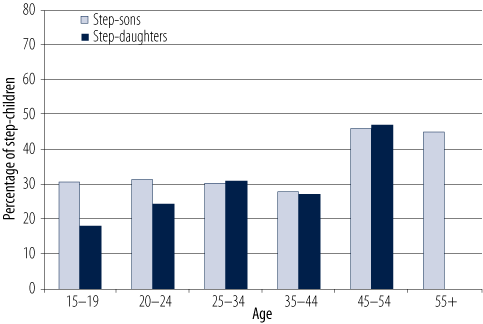
Note: High satisfaction refers to ratings of 9 or 10 on a scale ranging from 0, "completely satisfied" to 10, "completely satisfied". Results for step-daughters aged 55 or over are not provided owing to the small number of respondents in this group.
Source: HILDA 2004
Step-parents
- With the exception of step-fathers in the youngest group (25-34 years), the proportion of step-parents who were highly satisfied with their relationship with their step-children increased with age, with 56-60% in the oldest age group (65 years or more) expressing high satisfaction.
- Of the step-mothers, the youngest group (25-34 years) were the least likely to report high satisfaction with their relationship with their step-children (14%) while for step-fathers, high satisfaction was least likely to be reported by those aged 35-44 years (24%).
- Step-mothers in the three youngest groups were more likely to report low satisfaction than high satisfaction, with the pattern strongest among the youngest group (aged 25-34 years) (67% vs 14%) (data not shown for low satisfaction).
Step-children aged 15 years and older
- For both sexes, the oldest groups (step-sons and step-daughters aged 45-54 years and step-sons aged 55 or more years) were the most likely of all groups to indicate high satisfaction with their relationship with their step-parents (45-47%).
- Teenage girls were the least likely of all step-daughters to report high satisfaction with their relationship with their step-parents (18%), whereas there was little difference across the four younger groups of step-sons in their tendency to report high satisfaction.
- With the exception of the oldest group (aged 45-55 years), step-daughters were more likely to report low than high satisfaction - a trend that was particularly marked for teenage girls (64% expressed low satisfaction; 18% expressed high satisfaction) (data for low satisfaction not shown).
Opinions about whether parenting skills come naturally to most people
In the GPPS 2006, parents were asked to indicate the extent to which they agreed or disagreed with the statement "The skills needed to be a good parent come naturally to most people".
Both mothers and fathers were more likely to disagree than agree with the statement: 53% of all mothers and 56% of all fathers disagreed with the statement, while 33% of mothers and 38% of fathers agreed. In other words, parents generally rejected the notion that parenting skills come naturally to most people.
Figure 3.7 shows the extent to which fathers and mothers in different age groups strongly agreed or agreed with the statement.
- For both fathers and mothers, the tendency to endorse the statement declined with age. Agreement was expressed by:
- 58% of mothers in the youngest group (under 25 years) and only 27% of mothers in the oldest group (45-54 years); and
- 44% of fathers in the youngest group (25-34 years) and 31% of fathers in the oldest group (55+ years).
Figure 3.7 Strong agreement/agreement that the skills needed to be a good parent come naturally to most people, by age
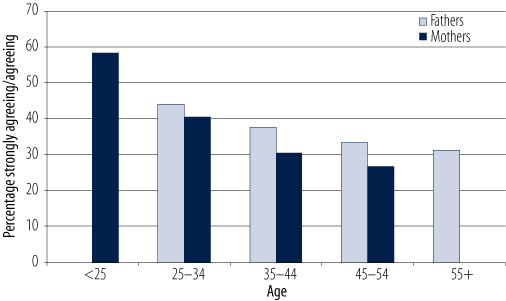
Source: GPPS (2006)
Help-seeking regarding parenting difficulties
As shown above, parents were more likely to reject than to accept the statement that good parenting and relationship skills come naturally to most people.16 This suggests that they believed that such skills are developed over time through experience or with the help of other people, or that the achievement of such skills is difficult for most people. The extent to which parents believed that people could rely on "on-the-job" experience or on advice from informal networks, written material or more formal programs was not ascertained. To explore their propensity to seek advice about parenting difficulties from formal sources, parents in the GPPS 2006 were asked "If you were to become aware of any difficulties in handling your child(ren)'s behaviour, apart from family or friends, where would you go for help?" In addition, parents were specifically asked whether they would use the following services if they had not already nominated them: counsellors or similar professionals; doctors/general practitioners; community health centres; and priests, religious leaders or elders.
Table 3.1 shows the common responses provided by the parents.
Both before any prompting and after prompting17, the most common sources of assistance nominated by both fathers and mothers were counsellors or similar professionals, and general health professionals.
Table 3.1 Expected sources of help that would be used by parents should difficulties in handling children's behaviour arise
| Before prompting | After prompting | |||
| Fathers (%) | Mothers (%) | Fathers (%) | Mothers (%) | |
| Counsellors or similar professionals (e.g., psychologist, psychiatrist, social worker or teachers) | 34.4 | 42.7 | 84.5 | 90.6 |
| General health professionals | 23.0 | 45.9 | 74.5 | 87.4 |
| Self-help (TV, books, magazine, Internet, etc.) | 5.8 | 5.8 | - | - |
| Priests, religious leaders/elders | 6.7 | 4.8 | 34.5 | 30.5 |
| Telephone services (e.g., Lifeline) | 4.0 | 8.0 | - | - |
| Don't know | 32.1 | 15.5 | - | - |
| Would not use any service | 5.2 | 2.8 | - | - |
| Number of observations | 2250 | 2749 | 2250 | 2749 |
Source: GPPS (2006)
Pattern of results before prompting
- Between 34% and 43% of parents nominated counsellors or similar professionals, while 23-46% nominated general health professionals, with mothers being more likely than fathers to nominate each of these sources of help (counsellors or similar: 43% vs 34%; general health professionals: 46% vs 23%).
- A wide range of other services was mentioned, although each of these other services was nominated by less than 10% of parents (the range of sources is not shown in Table 3.1).
- About 32% of fathers and only 16% of mothers indicated they did not know where they would go for help.
- Not surprisingly, the proportions of parents who indicated that they would seek help from each of the services subsequently mentioned by interviewers increased substantially.
Pattern of results after prompting
- Most parents indicated that they would consult with counsellors or similar professionals (85-91%) or general health professionals (75-87%) if they had difficulties in handling their children's behaviour.
- Consistent with the "pre-prompted trends", mothers were slightly more likely than fathers to report that they would use these services (counsellors or similar: 91% vs 85%; general health professionals: 87% vs 75%).
Sources of professional help sought with handling children's behaviour
Parents were also asked whether they had ever sought help from any source (other than family or friends) about difficulties in handling their children's behaviour.
- Only a minority of parents reported that they had done so, with a higher proportion of mothers than fathers indicating this (37% vs 26%).
- Parents who had sought help were most likely to indicate that they had consulted counsellors or similar professionals (63-70%), followed by general health professionals (39-52%).
16. Opinions about relationship skills are discussed in Chapter 2.
17. The results in the columns entitled "After prompting" refer to the proportion of all fathers and mothers who indicated that they would use the services listed - either before or after the interviewer suggested these services to them.
This chapter focuses on the following aspects of post-separation parenting arrangements:
- the views of parents with a child under 18 years about whether children of separated parents generally "do best" when both parents remain involved in the children's lives; and
- separated parents' reports about selected aspects of their post-separation parenting:
- the quality of the co-parental relationship;
- patterns of face-to-face contact between the non-resident parent and children and distance between residences; and
- child support payments.
Opinions about post-separation parental involvement
In the GPPS 2006, parents were asked to indicate their level of agreement or disagreement with the statement "Children generally do best after separation when both parents stay involved in their lives".
- Most parents agreed that the involvement of both parents is beneficial for children and there was little difference in the patterns of results for mothers and fathers: 75-79% agreed, 9-11% disagreed, and 13-15% expressed mixed feelings or uncertainty.
- Opinions of fathers and mothers varied little with their age.
Co-parental relationships
There is ample evidence that amicable (i.e., friendly, agreeable) relationships between separated parents are beneficial for the children and encourage cooperative parenting, while acrimonious relationships tend to be detrimental to all concerned and may encourage parents to undermine each other's parenting roles (Pryor & Rodgers 2001).
In the GPPS 2006, separated parents were asked to describe the quality of their relationship with their former partner and to indicate how often they communicated with their former partner about their children. Figure 4.1 summarises the views of separated parents about the nature of their relationship with their children's other parent.18
- About half the separated fathers and mothers reported that their relationship with their former partner was either "friendly" or "cooperative" (49-54%), with 30% describing the relationship as "friendly".
- About one-quarter of separated parents described their relationship as "distant" (24-25%).
- A relationship characterised by "lots of conflict" was reported by 17-19% of separated fathers and mothers.
- A small proportion of parents reported that their relationship with the former partner was "fearful", with mothers being more likely than fathers to indicate this (11% vs 2%).
Figure 4.1 Self-reported nature of separated parents' current relationship with their former partners, by gender
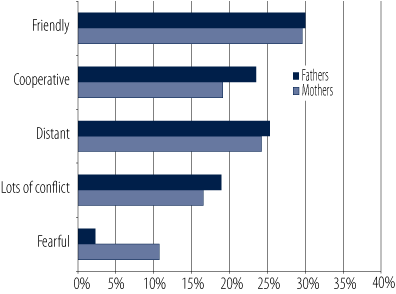
Source: GPPS (2006)
Figure 4.2 shows the frequency of inter-parental communication about the children reported by separated fathers and mothers.
- Just over one-third of separated fathers and mothers indicated that they talked to the other parent about their children at least once a week, 21-24% said that they talked to each other on a monthly basis, and 17-18% of the separated fathers and mothers reported that such discussions occurred less than once a month.
- About a quarter of separated parents (23-27%) indicated that they never communicated with their former partner about matters relating to their children.
Figure 4.2 Frequency of communication between separated parents about children, by gender
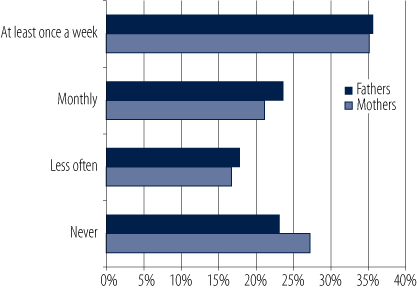
Source: GPPS 2006
Face-to-face contact between non-resident parents and children
While parents may believe that children benefit from the continuing involvement of both parents in their lives, such involvement may be difficult to achieve in practice, particularly when parents re-partner, the distance between residences increases, and children develop greater autonomy and interest in being with their friends.
In the Family Characteristics Survey (FCS) conducted by ABS in 2003, resident parents were asked how often each child aged under 18 years old usually saw his or her parent who lived elsewhere (mostly the father), how often he or she stayed overnight with the non-resident parent, and how many nights were involved in each period of stay. Figure 4.3 summarises responses on frequency of face-to-face contact between children and their non-resident parent.19
Figure 4.3 Frequency of face-to-face contact by children aged under 18 years with non-resident parent, as reported by resident parents
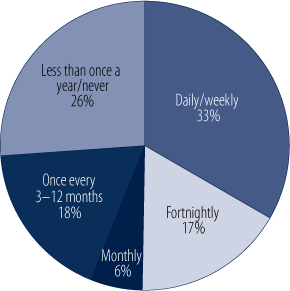
Source: ABS (2004)
According to reports of resident parents, the most common patterns were those at the extremes of frequency:
- One-third of children saw their non-resident parent on a daily or weekly basis, while around one-quarter saw their children less than once a year or not at all.
- Another 18% saw their parent only once every 3-12 months, while fortnightly and monthly face-to-face contact occurred for 17% and 6% of children respectively.
Resident parents' reports about face-to-face contact between children and their non-resident parent suggest that younger children had more frequent contact than older children (Table 4.1).
- According to resident parents' reports, daily or weekly contact declined with the increasing age of children (applying to 53% of children aged under 3 years and only 26% of children aged 15-17 years).
- Correspondingly, face-to-face contact that occurred only once every 3-12 months appeared to increase progressively with the increasing age of children (ranging from 8% for those under 3 years to 23% for those aged 15-17 years).
- The experience of less than yearly or no contact also appeared to increase with increasing age (applying to 21% of children under 3 years old and 30% of children aged 15-17 years).
Table 4.1 Frequency of face-to-face contact by children aged under 18 years with non-resident parent, by children's age, as reported by resident parents
| Children's age (years) | |||||
| 0-2 (%) | 3-4 (%) | 5-11 (%) | 12-14 (%) | 15-17 (%) | |
| Daily/weekly | 52.6 | 44.6 | 32.7 | 26.8 | 26.2 |
| Fortnightly | 13.1 | 16.2 | 18.9 | 19.1 | 12.1 |
| Monthly | 5.9* | 3.6* | 5.7 | 5.2 | 8.5 |
| Once every 3-12 months | 7.5* | 12.8 | 16.9 | 21.7 | 22.7 |
| Less than once a year/never | 20.9 | 22.9 | 25.8 | 27.2 | 30.4 |
| Total | 100.0 | 100.1 | 100.0 | 100.0 | 99.9 |
Note: * These estimates are subject to high standard error (25-50%), as indicated by the ABS.
Source: FCS 2003, unpublished customised tables
The pattern of overnight stays is depicted in Figure 4.4. The percentages provided refer to the proportions of children aged under 18 years who, according to their resident parent, experienced different ranges of overnight stays (from 0 to 182+ nights).
Figure 4.4 Overnight stays per year with non-resident parent by children aged under 18 years, as reported by resident parents
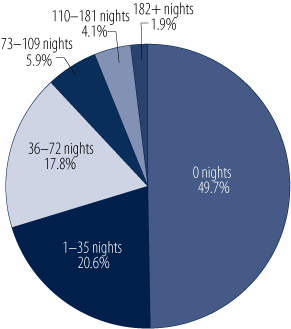
Source: ABS (2004). These data are based on the reports of resident parents.
The reports of resident parents suggest the following patterns in 2003:
- half the children experienced no overnight stays (i.e., they either had daytime-only face-to-face contact or never saw their non-resident parent);
- 38% spent up to 72 nights (i.e., 10 weeks, representing 20% of nights per year) with their non-resident parent, with 21% experiencing 1-35 nights (i.e., up to 5 weeks, representing up to 10% of nights per year);
- 10% spent 73-181 nights with their non-resident parent (i.e., 10-26 weeks, representing 20-50% of nights per year); and
- 4% spent 110-181 nights (i.e., 16-26 weeks or 3.6-6 months, representing 30-50% of nights per year) and 2% spent 182 nights or more (i.e., 6 months or more).
Table 4.2 shows the pattern of overnight stays experienced by children in five different age groups, as reported by their resident parents.
Table 4.2 Overnight stays per year with non-resident parent by children under 18 years, by children's age, as reported by resident parents
| Children's age (years) | |||||
| 0-2 (%) | 3-4 (%) | 5-11 (%) | 12-14 (%) | 15-17 (%) | |
| 0 nights | 66.7 | 51.9 | 44.2 | 45.7 | 57.1 |
| 1-35 nights | 11.9 | 12.3 | 21.7 | 22.7 | 24.7 |
| 36-72 nights | 13.1 | 21.7 | 21.0 | 17.6 | 11.0 |
| 73-109 nights | 5.1* | 7.8 | 6.4 | 6.7 | 3.1* |
| 110-181 nights | 3.3* | 5.7* | 4.2 | 4.7 | 2.6* |
| 182+ nights | 0.0 | 0.6* | 2.4 | 2.6* | 1.5* |
| Total | 100.1 | 100.0 | 99.9 | 100.0 | 100.0 |
Note: * These estimates are subject to high standard error (25-50%), as indicated by the ABS.
Source: FCS 2003, unpublished customised tables
- Most children aged under 3 years old (67%) or 15-17 years old (57%) did not have any overnight stays with their non-resident parents.
- The proportion experiencing overnight stays increased progressively with children's age for those of pre-school or primary school age (from 33% for those aged 0-2 years to 56% for those for those aged 5-11 years), while the proportions of older children staying overnight fell from 54% for those aged 12-14 years to 43% for those aged 15-17 years.
- Only 7-14% in each group spent more than 72 nights (or 10 weeks) with their non-resident parent.
- Less than 10% in each age group spent at least 110 nights (30% of nights) in a year with their non-resident parent.
Distance between children and non-resident parents would obviously affect the frequency of face-to-face contact experienced. The greater the distance between the child and his or her non-resident parent, the greater would be the travel costs, while mode of transport would affect travel time (car vs aeroplane). However, a short distance does not necessarily mean that children would have frequent contact with their non-resident parent. Figure 4.5 shows the distance between children aged under 18 years and their non-resident parent, as reported by resident and non-resident parents combined. These results are based on the HILDA survey (Wave 4, conducted in 2004).
- Over one-third of the children (37%) were living within 20 kilometres from their non-resident parent, while much the same proportion (34%) were living at least 100 kilometres apart, with nearly one quarter (22%) of children either living at least 500 kilometres away from their non-resident parent or having a non-resident parent who lived overseas.
- Only a small proportion of separated parents (5%) did not know the whereabouts of their children's other parent.
Figure 4.5 Distance between children and non-resident parents, as reported by parents
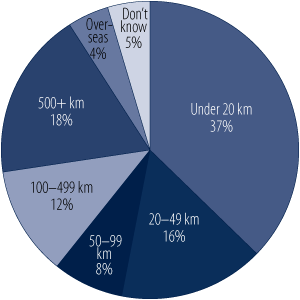
Source: HILDA 2004
Payment or receipt of child support
The Child Support Scheme, introduced in 1989-1991, is based on the principle that parents have the responsibility for the ongoing support of their children, regardless of whether they live with them. The scheme makes payments by parents who do not usually live with the child compulsory, at rates that are designed to reflect parents' capacity to pay. These rates, and the factors that are taken into account in determining them, have been recently revised and will come into effect on 1 July 2008.
This section focuses on the apparent incidence of child support payment transfers from one parent to the other, according to the reports of resident mothers, resident fathers and non-resident fathers in the FCS 2003, HILDA 2004 and the GPPS 2006:20
- Of the three groups, child support transfers were the most likely to be reported by non-resident fathers (who were payers) and the least likely to be reported by resident fathers (who were payees).
- Of non-resident fathers, 76-77% reported paying child support (in the GPPS and HILDA).
- Receipt of child support was reported by 62-66% of resident mothers in the FCS and GPPS, and by only 49% of resident mothers in HILDA.
- Of resident fathers, 18% in HILDA, 23% in the FCS, and 46% in the GPPS reported that they received child support.
The results from the datasets are more consistent in relation to the reports of non-resident fathers than reports of resident parents, although it should be noted that information from non-resident fathers about payment of child support was not derived in the FCS 2003. These differences may be partly explained by the different questions asked in each survey. The focus of the question (youngest child or all children) also varied across the surveys.21
The difference in the reports of resident mothers and fathers is likely to be linked with systematic differences between their former partners regarding their financial capacity to pay child support. The FCS 2003 showed that, compared with non-resident mothers, non-resident fathers had greater attachment to paid work, were more likely to live alone and less likely to be single parents (i.e., unpartnered and living with at least one child).22
18. It is important to note that relationships that are "friendly" would also seem likely to be "cooperative", while "cooperative" relationships may well occur in the absence of friendliness. Therefore, for some but not all parents, the choice between these alternatives may be arbitrary. Similarly, "fearful" seems likely to suggest a relationship involving "lots of conflict" (whether overt or covert), while the reverse would not necessarily apply.
19. It is important to note that parents’ reports on contact patterns and levels of child support tend to differ according to their residence status. Compared with non-resident parents, resident parents tend to report more limited contact (Parkinson & Smyth, 2003).
20. While information about child support transfers in the FCS 2003 was derived from resident parents only, such information was derived from both parents in HILDA 2004 and the GPPS 2006.
21. In the HILDA survey, resident parents were asked: "Do you receive any financial support from, or pay any financial support to [youngest child’s] other parent to help meet general everyday expenses of [youngest child]. For instance, any weekly, fortnightly or monthly child support. Exclude any payments to cover one-off or periodic expenses such as school fees or medical bills". A parallel question was asked of non-resident parents. The FCS asked resident parents to indicate the usual amount of child support or maintenance received each month for the children. This is closest to the question asked in the HILDA survey, although it is possible that some parents included other forms of financial support. In both HILDA and the FCS, parents were asked subsequently about these other forms of support. The GPPS asked: "Do you currently pay (or receive) any regular financial support for the child(ren)?"
22. In other words, although these mothers and fathers were non-resident parents to one or more of their children, the mothers were more likely than the fathers to also have at least one of their children living with them. These children may have been full or half siblings of the children living elsewhere.
Grandparents can play many important roles in children's lives. They can be loving companions, caregivers, mentors, historians and sources of various other forms of support. In some cases, they also can become surrogate parents.23
While many grandparents appear to welcome the opportunity to commit to frequent, regular and lengthy periods with their grandchildren, others prefer to pose heavy restrictions on the time they spend with them. Still others live too far away from their grandchildren to see them frequently, if at all (see Ochiltree, 2006). And, like all relationships, those between grandparents and grandchildren evolve and are not always beneficial to one or both parties. The relationships would tend to change in response to the grandchildren's increasing maturity and the ageing of their grandparents, and other changing circumstances, such as parental separation and/or residential relocation.
This chapter explores the closeness of relationships between grandchildren and their paternal and maternal grandparents, as well as the impact of separation on these relationships, as perceived by the children's parents. These results are based on the GPPS 2006.
Current relationship between grandchildren and grandparents
Respondents who had at least one living parent were asked to indicate whether the relationship between their own parents and children was "very close", "close", "not close" or "non-existent". Reports that the relationship varies were recorded, although this response option was not suggested to respondents. Respondents were also asked the same questions about the relationship between their children and grandparents on their other side. It is worth noting that no distinction was made between specific children in the family, nor between grandmothers and grandfathers. For simplicity, the discussion below refers to "maternal grandparents", "paternal grandparents" and "children" or "grandchildren" (i.e., plural terms are used). Figure 5.1 summarises the patterns of answers provided by fathers and mothers.
- Most mothers and fathers described the relationship between their children and their maternal and paternal grandparents as "close" or "very close" (67-85%).
- Both mothers and fathers were more likely to consider that their children had a "very close" relationship with their maternal grandparents than with their paternal grandparents (mothers: 56% vs 32%; fathers: 46% vs 39%).
- However, views appeared to be influenced by whether the grandparents were on the respondents' side or their partner's side. Specifically:
- mothers were more likely than fathers to describe relationships between the children and their maternal grandparents as "very close" (56% vs 46%)
- similarly, fathers were slightly more likely than mothers to report "very close" relationships between the children and their paternal grandparents (39% vs 32%).
Figure 5.1 Perceived current relationship between grandchildren and their grandparents, by gender of parent, as reported by parents
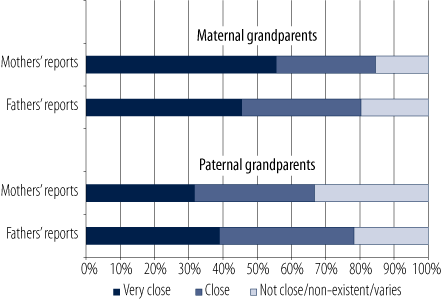
Source: GPPS 2006
Figure 5.2 summarises the views of separated and non-separated parents regarding the closeness of the relationship between their own parents and children. The separated parents are divided into three groups: resident and non-resident fathers, and resident mothers.24
- Of the five groups of parents, "very close" relationships between their own parents and children were most likely to be reported by mothers who were not separated (58%), followed by resident fathers and resident mothers (51-55%), then fathers who were not separated (41%).
- Patterns of responses of resident fathers and mothers were very similar: 51-55% of resident fathers and mothers described the relationship between their children and their parents as "very close", while 13-18% described it as "not close", "non-existent" or "varies".
- Of all groups, non-resident fathers were the least likely to report that the relationship was "very close" (19% vs 41-58%) and the most likely to describe the relationship as either "not close" or "non-existent", or one that "varies" (41% vs 13-20%).
Figure 5.2 Perceived current relationship between own parents and children, by separation and residence status, as reported by parents
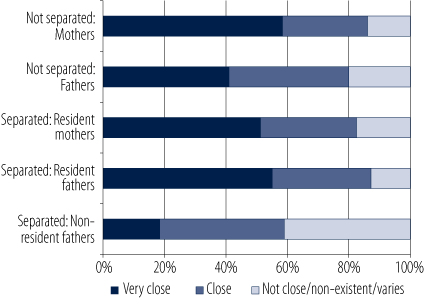
Note: * There were too few separated mothers who were not living with any of their children (i.e., non-resident mothers, n=12) to provide results for this group.
Source: GPPS 2006
Perceived impact of separation on relationship between grandchildren and grandparents
Separated parents were asked to indicate whether they believed that the relationship between their own parents and children had become closer or more distant, or whether the relationship had not changed since their separation. Figure 5.3 shows the pattern of answers of separated fathers and mothers to this question, according to their residence status.
- Both fathers and mothers most commonly maintained that the relationships between their own parents and children had not changed since separation (51-58%).
- However, perceived changes in the relationship between their own parents and children varied according to parents' residence status. Specifically:
- Resident fathers and mothers were more likely to maintain that this relationship had become closer rather than more distant (closer: 36%; more distant: 6-8%), while the reverse applied to non-resident fathers (closer 13%; more distant 36%).
Figure 5.3 Perceived changes in relationship between own parents and children, by residence status, as reported by separated parents
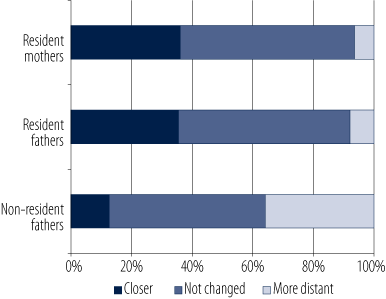
Source: GPPS 2006
The closeness of a relationship does not necessarily reflect how beneficial that relationship is for each party. Nevertheless, most parents who believed that relationships had become closer also believed that such a change had beneficial effects on the children (66%). On the other hand, of those parents who considered that the children's relationship had become more distant, 58% described the impact as being minimal or mixed, while 34% considered the impact to be negative.
- Amato, P. R. (2005). The impact of family formation change on the cognitive, social and emotional wellbeing of the next generation. The Future of Children, 15(2), 75-96.
- Amato, P. R., & Booth, A. (2000). A generation at risk: Growing up in an era of family upheaval. Cambridge, MA: Harvard University Press.
- Ambert, A. M. (1997). Parents, children, and adolescents: Interactive relationships and development in context. New York: Haworth Press.
- Australian Bureau of Statistics. (various years). Divorces Australia. Canberra: Author.
- Australian Bureau of Statistics. (1996). Marriages and divorces Australia 1995 (Cat. No. 3310.0). Canberra: Author.
- Australian Bureau of Statistics. (2000). Marriages and divorces Australia 1999 (Cat. No. 3310.0). Canberra: Author.
- Australian Bureau of Statistics. (2001). Births Australia 2000 (Cat. No. 3301.0). Canberra: Author.
- Australian Bureau of Statistics. (2002a). Marriages and divorces Australia 2001 (Cat. No. 3310.0). Canberra: Author.
- Australian Bureau of Statistics. (2002b). Births Australia 2001 (Cat. No. 3301.0). Canberra: Author.
- Australian Bureau of Statistics. (2004). Family characteristics Australia (Cat. no. 4442.0). Canberra: Author.
- Australian Bureau of Statistics. (2007a). Marriages Australia 2006 (Cat. No. 3306.0.55.001). Canberra: Author.
- Australian Bureau of Statistics. (2007b). 2006 Census tables (Cat. No. 2068.0). Canberra: Author.
- Australian Bureau of Statistics. (2007c). Births Australia 2006 (Cat. No. 3301.0). Canberra: Author.
- Australian Institute of Family Studies. (2004) Family facts & figures. Melbourne: Author. Retrieved 8 April 2008, from http://www.aifs.gov.au/institute/info/charts/cohabitation/outcomes.html
- Brown, S. L. (2000). The effect of union type of psychological well-being: Depression among cohabitors versus marrieds. Journal of Health and Social Behavior, 41, 12-24.
- de Vaus, D. (1997). Family Values in the Nineties Gender gap or generation gap? Family Matters, 48, 5-10.
- Dolan, P. D., Peasgood, T., & While, M. (2006). Review of research on the influences on personal well-being and application to policy making. London: Department of Environment, Food and Rural Affairs.
- Haller. M., & Hadler, M. (2006). How social relations and structures can produce happiness and unhappiness: An international comparative analysis. Social Indicators Research, 74, 169-216.
- Hugo, G. (2007). Recent trends in Australian fertility. O & G, 9(2), 11-13.
- McCabe, M. P., Cummins, R. A., & Romeo, Y. (1996). Relationship status, relationship quality, and health. Journal of Family Studies, 2(2), 109-120.
- McDonald, P. (2006). Low fertility and the state: The efficacy of policy. Population and Development Review, 32(3), 485-510.
- Ochiltree, G. (2006). Grandparents, grandchildren and the generation in between. Melbourne: ACER.
- Parkinson, P., & Smyth, B. (2003). When the difference is night & day: Some empirical insights into patterns of parent-child contact after separation. Paper presented at the 8th Australian Institute of Family Studies Conference, Melbourne.
- Pryor, J., & Rodgers, B. (2001). Children in changing families: Life after parental separation. Oxford: Blackwell.
- Sanders, M. R., Nicholson, J. M., & Floyd, F. J. (1997). Couples' relationships and children. In W. K. Halford & H. J. Markman (Eds.), Clinical handbook of marriage and couples intervention (pp. 225-253). Chichester, UK: John Wiley and Sons.
- Smyth, B., & Wolcott, I. (2004). Food and family transitions: Cooking in the aftermath of divorce. Journal of the Home Economics Institute of Australia, 11(3), 2-8.
- Tweng, J. M., & King, L. A. (2004). A good life is a personal life: Relationship fulfilment and work fulfilment in judgements of life quality. Journal of Research in Personality, 39(3), 336-353.
- Watson, N., & Wooden, M. (2002). The Households, Income and Labour Dynamics in Australia (HILDA) Survey: Wave 1 survey methodology (HILDA Project Technical Paper Series No. 1/02). Melbourne: Melbourne Institute of Applied Economics and Social Research. Retrieved 8 April 2008, from http://www.melbourneinstitute.com/hilda/hdps/hdps-techn01.pdf
- Weston, R. (2004), Having children or not. Family Matters, 69, 4-9.
In addition to statistics published by the Australian Government Australian Bureau of Statistics (e.g., on marriages and divorces), this snapshot has drawn on data from following surveys:
- The General Population of Parents Survey (GPPS 2006) - a telephone survey of a nationally representative sample of 5,000 parents (with a child under 18 years old) living in private dwellings. This survey was conducted in June/July 2006 and was funded by the Australian Government Attorney-General's Department and the Department of Families, Housing, Community Services and Indigenous Affairs (FaHCSIA).
- The Household, Income and Labour Dynamics in Australia (HILDA) survey (Wave 4, undertaken in 2004) - a national panel survey that commenced in 2001, is conducted annually and involves both face-to-face interviews and self-completed questionnaires (see Watson & Wooden, 2002, for details of the survey methodology). HILDA is funded by the Australian Government, through FaHCSIA, and is managed by a consortium led by the Melbourne Institute of Applied Economic and Social Research, University of Melbourne. The information in Wave 4 was derived from approximately 12,400 persons aged 15 years and over, from around 7,000 households.
- The 2003 ABS Family Characteristics Survey (FCS 2003) - a national (mostly telephone) survey conducted as part of the ABS monthly Labour Force Survey (LFS). The dataset contains records of 24,498 households and 61,859 persons.
Qu, L., & Weston, R. (2008). Snapshots of family relationships (Facts Sheet). Melbourne: Australian Institute of Family Studies.
978 1 921414 04 6